Singapore Civil Defence Force
The Singapore Civil Defence Force (abbreviation: SCDF; Malay: Pasukan Pertahanan Awam Singapura; Chinese: 新加坡民防部队; Tamil: சிங்கப்பூர் குடிமைத் தற்காப்புப் படை) is an emergency service in Singapore under the Ministry of Home Affairs that provides firefighting, technical rescue, and emergency medical services and coordinates national civil defence.[1]
| Malay: Pasukan Pertahanan Awam Singapura
Chinese: 新加坡民防部队 Tamil: சிங்கப்பூர் குடிமைத் தற்காப்புப் படை | |
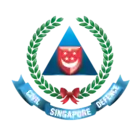 | |
| The Life Saving Force | |
| Operational area | |
|---|---|
| Country | |
| Agency overview | |
| Established | 6 November 1982 |
| Annual calls | 191,492 (2018) |
| Employees | 6,000 |
| Annual budget | SGD 617 million (2019) |
| Commissioner | COMR Eric Yap Wee Teck |
| EMS level | ALS |
| Facilities and equipment | |
| Divisions | 5 |
| Stations | 22 |
| Engines | 26 |
| Ambulances |
|
| HAZMAT | 13 |
| Fireboats | 4 |
| Website | |
| Official website | |
History
Singapore's first Fire Committee was formed in 1855. Prior to this, fires were attended to by uniformed groups which included the police, sepoys, marine soldiers and even convicts. On 7 September 1869, the Governor Major-General Sir Harry St. George Ord enacted the Fire Ordinance and appointed the Colonial Engineer as Chairman of the Fire Commission for Singapore. This Fire Commission was however later disbanded in 1884 due to poor organisation and difficult circumstances. In 1888, the Singapore Fire Brigade was established as a fully-equipped professional brigade with sufficient funding. By 1909, there were a total of three built stations servicing Singapore, namely Central Fire Station at Hill Street, Cross Street and Kallang Fire Stations. In 1980, the brigade was officially renamed the Singapore Fire Service (SFS).[2]
In 1982, the National Civil Defence Plan was launched which spearheaded the emergency preparedness for the nation. With the enactment of the Civil Defence Act in 1986, the Singapore Civil Defence Force (SCDF) was established as an organisation under the Ministry of Home Affairs. In the same year, the Hotel New World disaster paved the way for joint operations between the SCDF and SFS. The SCDF and SFS were merged on 15 April 1989.[3]
The newly integrated SCDF mainly used facilities which were handed over from the Singapore Armed Forces (SAF) or the Singapore Police Force (SPF). Since the early 2000s, its headquarters and territorial divisions have all moved into purpose-built facilities. SCDF's involvement in regional disaster relief operations has also raised its profile significantly.
On 18 January 2009, SCDF was classified by INSARAG as a heavy urban search and rescue team, the highest level of urban search and rescue service.[4]
Organisation structure
SCDF is led by the Commissioner of the SCDF and three deputy commissioners, each in charge of Strategy & Corporate Services, Operations & Resilience and Future Technology & Public Safety. The SCDF is organised with one headquarter element commanding seven divisions. Of the latter, four (1st, 2nd, 3rd, and 4th Divisions) are territorial divisions; another two are training divisions, namely the Civil Defence Academy (CDA) and National Service Training Institute (NSTI), and can be activated as the 5th and 6th Divisions respectively in times of emergency; the seventh is the Marine Division, which was set up on 1 April 2012 with the capability and capacity to respond to marine fire and rescue incidents.
Headquarters
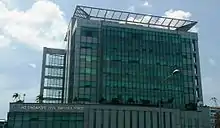
The headquarters complex of SCDF contains the command centre for all operations nationwide. It is co-located with the Disaster Assistance and Rescue Team Base, Central Supply Base and Paya Lebar Fire Station in a single compound on Ubi Avenue 4.
Operational divisions
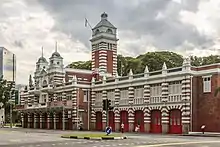
Each territorial division is given territorial responsibility of a region of Singapore, and possesses its own command centre, hazmat capabilities, and internal administration.
| Division | Responsibility | Fire Stations | Location |
|---|---|---|---|
| 1st Division | Covers the general south of Singapore, stretching from Clementi to the Central Business District (CBD), and also includes Jurong Island, an oil refining centre. | Central, Alexandra, Clementi, Jurong Island, Bishan, Banyan, Marina Bay, and Sentosa | Queenstown (co-located with Queenstown Neighbourhood Police Centre and Alexandra Fire Station) |
| 2nd Division | Covers the east of Singapore, including Changi Airport. | Paya Lebar, Changi, Tampines, and Kallang | Tampines (co-located with Tampines Fire Station) |
| 3rd Division | Covers the north of Singapore. | Yishun, Ang Mo Kio, and Sengkang | Yishun (co-located with Yishun Fire Station) |
| 4th Division | Covers the west of SIngapore. | Jurong, Tuas, Woodlands, Bukit Batok, and Tuas View | Bukit Batok (co-located with Bukit Batok Fire Station) |
| Marine Division (7th Division) | Covers marine fire and rescue incidents. | West Coast and Brani | Pulau Brani (co-located with Brani Marine Fire Station) |
Training divisions
The Civil Defence Academy (CDA) conducts training for the various vocations and specialisations within the SCDF, including the Section Commander Course (SCC) and Rota Commander Course (RCC).
The National Service Training Institute (NSTI) conducts training for national servicemen. It consists of the Basic Rescue Training Centre (BRTC), which conducts basic training for new enlistees in basic rescue skills and fitness, and the In-Camp Training Centre (ICTC), which trains Operationally Ready NSmen. Tucked in a corner of NSTI is the Civil Defence Detention Barracks under the purview of the SCDF Provost Units. Detainees from both SCDF and SPF are detained here throughout the duration of their detention. Subunits of the Provost Unit are also housed here.
The Home Team Tactical Centre provides an additional training ground for trainees to experience. It replaces the Mandai Training Village which has since been demolished.
List of appliances
The SCDF maintains a large fleet of custom-made vehicles (referred to as appliances) that are capable of mitigating a variety of incidents. Many of the appliances were designed and commissioned by the SCDF rather than ready-made designs.
Ambulance
The ambulance forms the backbone of Singapore's medical emergency response capability and is the most widely deployed appliance. Each ambulance is staffed by an ambulance driver, a paramedic, and an emergency medical technician. Occasionally, a Fire & Rescue Specialist (FRS) or ERS trainee may also be attached to an ambulance unit.
Medical Support Vehicle (MSV)
The Medical Support Vehicle (MSV) is a truck that is designed to provide on-site treatment capabilities for mass casualty incidents. On reaching the incident site, it is able to fold out and expand to form a mobile aid station to perform on-site stabilisation and critical invasive medical treatment.
Firefighting appliances
.JPG.webp)
Fire Bike
The Fire Bike, also known as the Red Scorpion, is a three-wheeled Piaggio MP3 that carries a single firefighter. They are able to navigate traffic to provide a faster initial response to emergencies. The Fire Bike carries a compressed air foam backpack which can extinguish handle smaller conflagrations such as household and vehicle fires. It is also equipped with an automated external defibrillator to respond to medical emergencies in concert with an ambulance.
Light Fire Attack Vehicle (LFAV)
The Light Fire Attack Vehicle (LFAV), also known as the Red Rhino, was first introduced in 2000. It is designed to be more compact than a traditional fire engine, allowing it to be stationed at a larger variety of locations.
The most recent iteration is the 6th generation, unveiled in 2018 at the SCDF Workplan Seminar. Instead of the traditional 4-man crew in the previous LFAV generations, the 6th generation carries a robot named the Red Rhino Robot (3R) which fits in the rear passenger compartment. The 3R conducts reconnaissance operations to locate the seat of fire through the use of thermal imaging and relay the information to the operator, who can then direct firefighting operations. The robot is able to mitigate a fire within confines of approximately 15m2.[5][6]
Pump Ladder (PL)
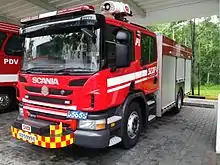
The Pump Ladder (PL) is the workhorse fire engine of the SCDF. It carries 2,400 litres of water and 1,200 litres of foam, along with other rescue and firefighting equipment. The PL is also equipped to set up hasty decontamination facilities for a chemical incident. The decontamination lanes can be set up within four minutes, and each lane is able to decontaminate up to 36 walking casualties or six lying casualties per hour. The Generation E of the PL features a compress air foam pump.
Combined Platform-Ladder (CPL)
_Vehicle%252C_Singapore_Civil_Defence_Force%252C_Nov_06.JPG.webp)
The Combined Platform-Ladder (CPL) is a hydraulic ladder-platform truck which is used to conduct external firefighting and rescue operations involving high-rise buildings. There are several variants of CPL in SCDF, the largest being the CPL60 which can extend its platform ladder up to a maximum height of 60 metres, the equivalent of a 20-storey building. Its platform is equipped with a water monitor capable of discharging water at the rate of 3,800 litres per minute, and a rescue cage that can hold up to 500 kg.[7]
Aerial Ladder (AL)
The Aerial Ladder (AL) is a ladder truck used in the SCDF for aerial firefighting and rescue. It has an operational height of 56 metres.
Fire and Rescue Operations Support Tender (FROST)
The Fire and Rescue Operations Support Tender (FROST) is a support appliance that provides additional sets of self-contained breathing apparatus, thermal imaging cameras, gas detectors and smoke and water extraction functions to facilitate difficult or prolonged rescue operations.
It was designed to consolidate the functions of the previous Breathing Apparatus Tender (BAT) and Damage Control Tender (DCT), halving the total manpower needed for these functions from eight to four.
Tracked Firefighting Vehicle (TFV)
The Tracked Firefighting Vehicle (TFV) is a Bandvagn 206 that is used in forested areas where wheeled vehicles may have difficulty navigating. These vehicles were transferred from the Singapore Armed Forces to the SCDF and subsequently repainted and fitted with firefighting equipment and capabilities. (RECENTLY DECOMMISSIONED)
Modular Oil Tank Firefighting System (MOTFS)
The Modular Oil Tank Fire-Fighting System (MOTFS) is an oil tank fire fighting system capable of discharging large volumes of foam for large-scale fires, up to 100,000 litres per minute. It is also capable of drafting water supply directly from open sources such as the sea or marine vessels. It is also designed in a modular form to speed up deployment to match the scale of the incident.[7]
Unmanned Firefighting Machine (UFM)
The Unmanned Firefighting Machine (UFM) is a remote controlled fire-fighting unit built to operate in extreme heat and hazardous environments, by using high velocity airflow to create ventilation in smoke-logged areas, and intense water mist, jet or foam to put out fires. It was first launched in April 2014. In 2015, the UFM added a rail kit to enable the unit to manoeuvre in Mass Rapid Transit tunnels at up to 40 km/h to put out fires and conduct ventilation operations.[8]
Pumper Firefighting Machine
The custom-built Pumper Firefighting Machine can traverse up and down a staircase, fit into passenger lifts and penetrate through premises with a maximum temperature of 250-degree Celsius for up to 10 minutes. Other unique features include a rotating nozzle that can project water mist in 360-degree angles to quickly lower room temperatures and a high pressure hose reel with a built-in water tank that can allow firefighters to quickly initiate firefighting operations at incidents. Its resistance to heat also means that firefighters will be less exposed to risk during firefighting operations.[6]
Hazmat Mitigation Vehicle
The Hazmat Mitigation Vehicle (HMV) is a hazardous materials apparatus that transports Hazmat personnel and their equipment to an incident site. The HMV carries a Hazmat Utility Buggy (HUB) in the rear of the appliance, where it can be unloaded to assess incident developments, transport equipment and convey casualties out of the hazard area.
Hazmat Decon Pod
The Hazmat Decon Pod conducts environmental decontamination by sucking in contaminated air and purifying it at a high rate to remove hazardous material and render an area more hospitable for work following a chemical, biological, radiological and nuclear incident.
Mass Decontamination Vehicle (MDV)
The Mass Decontamination Vehicle (MDV) is a large bus that is able to transport personnel and equipment, perform the decontamination of a large number casualties, and convey the casualties to the hospital.[9]
Hazmat Control Vehicle
The Hazmat Control Vehicle carries a chemical detector to detect and monitor chemical release from up to 5 km away. It is also fitted with a launchpad for unmanned aerial vehicles to extend the range and altitude of its chemical detection capabilities.[10][6]
Command Vehicle (CV) and Forward Command Vehicle (FCV)
The Command Vehicle (CV) functions as a mobile headquarters command and control centre. The vehicles are the size of a large bus, and when deployed, the body of the vehicle stretches to thrice its size on the road, allowing ample space inside the vehicle for personnel and essential computer and communications equipment. CVs are deployed to strategic locations to provide forward tactical headquarters capability in major incidents or high-risk events.
Hazmat Command Vehicle (HCV)
The Hazmat Command Vehicle (HCV) is a command post specifically designed for command and control during a CBR incident. It is equipped for this task with a wide array of instruments and sensors which can, for example, monitor and help predict toxic material presence and dispersion in the wind.
DART Rescue Vehicle (DRV)
The DART Rescue Vehicle (DRV) is a specialised appliance of the Disaster Assistance and Rescue Team designed for urban search and rescue. It carries a personnel cabin and can accommodate up to eight DART officers with their equipment. The DRV is equipped with a crane with a load capacity of 7.9 tonnes. It is primarily used to load other rescue vehicles like the DART skid loader, which is used to access confined spaces in collapsed buildings.[10]
Fireboats
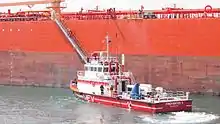
In 2012, the Singapore Civil Defence Force took over responsibility from the Maritime Port Authority for fighting maritime fires.[11] By 2019, the SCDF Marine Division had retired some old fireboats, and added six new modern vessels, bringing the size of the firefighting fleet to eight vessels.[12][13] One of the new vessels, the Red Sailfish, is the most powerful fireboat in the world so far.
Operation Lionheart
SCDF maintains a rescue contingent on 24-hour standby under the codename Operation Lionheart to provide rescue and humanitarian assistance and support to countries stricken by major disasters. Since its formation in 1990, the Operation Lionheart contingent had responded to 16 overseas missions.[14]
Below is the breakdown of the missions:
| Disaster | Country | Year |
|---|---|---|
| Baguio City Earthquake | Baguio City, Philippines | Jul 1990 |
| Highland Towers Collapse | Kuala Lumpur, Malaysia | Dec 1993 |
| Tai Chung County Earthquake | Taiwan | Sep 1999 |
| Asian Tsunami Disaster | Aceh, Indonesia | Dec 2004 |
| Asian Tsunami Disaster | Khao Lak, Thailand | Dec 2004 |
| Sumatra Earthquake | Nias Island, Indonesia | Mar 2005 |
| Rokan Hilir Bush Fires | Sumatra, Indonesia | Aug 2005 |
| South Asian Earthquake | Muzaffarabad, Pakistan | Oct 2005 |
| Central Java Earthquake | Central Java, Indonesia | May 2006 |
| Sichuan Earthquake | Sichuan, China | May 2008 |
| Padang City Earthquake | Sumatra, Indonesia | Oct 2009 |
| Christchurch Earthquake | Christchurch, New Zealand | Mar 2011 |
| Japan Earthquake | Soma City, Japan | Mar 2011 |
| Malaysia, Flood | Kelantan, Malaysia | Dec 2014 |
| Thailand, Forest Fire | Chiang Mai, Thailand | Mar 2015 |
| Nepal Earthquake | Kathmandu, Nepal | May 2015 |
Ranks
These ranks feature the following charges:
- Chevrons — a V-shaped marking
- Curved Bar — a U-shaped marking
- Pips — Four-sided starbursts with the crescent and stars from the National Arms of Singapore at the centre
- National Arms — The National Arms of Singapore when used as a rank insignia is rendered differently from its original depiction. The rank version of the National Arms still depicts the lion, tiger and the shield with the crescent & five stars. However, the rank version of the National Arms replaces the original water spurts with palm laurels and does away with the motto-scroll bearing "Majulah Singapura"
- Commissioner's Badge — Two axes in saltire within laurels
The ranks are displayed here in descending order from highest seniority at the top to lowest at the bottom.
Commissioners
- (COMR) Commissioner — Commissioner's Badge, topped with a pip and the National Arms, in that order
- (DC) Deputy Commissioner — Commissioner's Badge, topped with the National Arms
- (SAC) Senior Assistant Commissioner — Commissioner's Badge, topped with two pips
- (AC) Assistant Commissioner — Commissioner's Badge, topped with a pip
Senior Officers
- (COL) Colonel — three National Arms
- (LTC) Lieutenant-Colonel — two National Arms
- (MAJ) Major — one National Arms
- (CPT) Captain — three pips
- (LTA) Lieutenant — two pips
Junior Officers
- (WO2) Warrant Officer(2) — National Arms enclosed by a curved bar below and two inverted chevrons above
- (WO1) Warrant Officer(1) — National Arms enclosed by a curved bar below and an inverted chevron above
- (SGT) Sergeant — three chevrons
- (CPL) Corporal — two chevrons
- (LCP) Lance Corporal — one chevron
- (PTE) Private — no insignia
Cadets/ Trainees
- (OCT) Officer Cadet, Senior — two horizontal bars
- (OCT) Officer Cadet, Junior — one horizontal bar
- (SCT) Specialist Cadet, Senior — two inverted chevrons
- (SCT) Specialist Cadet, Junior — one inverted chevron
- (REC) Recruit — no insignia
All epaulettes and shoulder boards bear the title "CIVIL DEFENCE" underneath all rank insignia.
In popular culture
Fictional television programs:
- Fiery Passion (烈焰焚情), 12 February 1992
- On the Frontline (穿梭生死线), 2000
- Life Line, 2005
- Without Warning 26 October 2006
- Life Line 2, 15 May 2007
- Rescue 995 (九九五), 6 February 2012
Controversies
On 19 December 2011, former commissioner Peter Lim Sin Pang[15] was arrested on graft charges in connection with an IT contract.[16][17][18][19][20] Lim was dismissed from service in August 2013.[21] He was sentenced to jail for six months.[22]
In October 2015, former director Jeganathan Ramasamy was sentenced to 10 weeks' jail for misappropriating two iPads in September 2011. He had allegedly assumed the two iPads obtained from SCDF vendors were for personal use, and had given one to his daughter and sold the other to another senior director Eric Yap Wee Teck who was to later became Commissioner of the SCDF.[23]
On 13 May 2018, full-time national serviceman Corporal Kok Yuen Chin drowned in a fire station's pump well during a ragging incident when his colleagues attempted to celebrate his transition to an operationally ready reservist. Those involved were arrested, charged in court and jailed.[24][25][26][27] 2 of them have been dismissed from service.[28]
myResponder App
SCDF's myResponder App responds citizens through the app to emergency situations, such as cardiac arrests and/or fires. When an emergency call comes through to the 995 operations centre, community first responders within 400m of the incident location are alerted through the app to respond and provide assistance. Upon arrival, community first responders can provide CPR & utilise AEDs on persons in cardiac arrest (before ambulances arrive) or extinguish minor fires while they are still in the early growth stage (before fire appliances arrive). [29]
See also
- Civil defence by nation
- Civil Defence Auxiliary Unit
- Compulsory Fire Service
- National Service in Singapore
- National Civil Defence Cadet Corps
- SAMU, an equivalent organisation in France
References
- Citations
- "SCDF Website – GENERAL: About Us". Archived from the original on 28 December 2016. Retrieved 18 June 2011.
- Tan, Bonny (2016). "Singapore Fire Brigade". Retrieved 16 June 2020.
- "SCDF Website – GENERAL: Milestones". Archived from the original on 27 September 2011. Retrieved 18 June 2011.
- "Ministry of Home Affairs (MHA)". www.mha.gov.sg. Archived from the original on 25 July 2011.
- https://www.scdf.gov.sg/docs/default-source/scdf-library/sgfpc/reaction-publication-special-edition-2018.pdf
- "Rescue 995" (PDF).
- "SCDF's Latest Initiatives As Unveiled at the SCDF Workplan Seminar 2019". SCDF. Retrieved 21 September 2019.
- "SCDF's Unmanned Firefighting Machine adapted for operations in MRT tunnels". TODAYonline. Retrieved 21 September 2019.
- "Singapore Civil Defence Force". www.facebook.com. Retrieved 21 September 2019.
- "SCDF unveils 2 new vehicles to boost response to chemical leaks, rescue missions". TODAYonline. Retrieved 21 September 2019.
- Hariz Baharudin (4 May 2017). "Singapore Civil Defence Force unveils new vessels to boost firefighting at sea". The New Paper. Singapore. Archived from the original on 4 May 2017. Retrieved 21 August 2019.
SCDF took over marine firefighting and rescue operations from the Maritime and Port Authority of Singapore (MPA) five years ago.
- Kevin Kwang (20 August 2019). "SCDF unveils 'world's most powerful firefighting vessel' to boost response to maritime emergencies". Channel News Asia. Singapore. Archived from the original on 20 August 2019. Retrieved 21 August 2019.
Three new firefighting vessels, including one the Singapore Civil Defence Force (SCDF) touted as the "world’s most powerful firefighting vessel", was commissioned by Home Affairs and Law Minister K Shanmugam on Tuesday (20 Aug).
- Charmaine Ng (20 August 2019). "SCDF unveils 'world's most powerful marine firefighting vessel'". Straits Times. Singapore. Archived from the original on 20 August 2019. Retrieved 21 August 2019.
Three new marine firefighting vessels - including the world's most powerful in terms of water output - were commissioned by the Singapore Civil Defence Force (SCDF) on Tuesday (20 Aug).
- "SCDF Website – NEWS: SCDF deploys rescuers to New Zealand". Archived from the original on 27 September 2011. Retrieved 18 June 2011.
- "Gallery: Corruption trial of ex-SCDF chief Peter Lim underway". MediaCorp Press Ltd. Archived from the original on 8 December 2015. Retrieved 13 January 2015.
- AsiaOne (14 February 2012). "Premature announcement would have compromised CPIB investigations: DPM Teo". AsiaOne. Archived from the original on 29 October 2017. Retrieved 17 January 2017.
- Chua Lee Hoong (28 January 2012). "Govt will follow through on CPIB probe into 2 top men: PM Lee". Straits Times. Archived from the original on 25 June 2012. Retrieved 17 January 2017.
- Toh Yong Chuan (28 January 2012). "CPIB probe: Duo facing civil service disciplinary proceedings as well". Straits Times.
- Leonard Lim (26 January 2012). "CPIB: Top men were arrested, being probed for graft". Straits Times.
- "Woman in centre of CPIB probe leads double life". AsiaOne. 28 January 2012. Archived from the original on 19 July 2016. Retrieved 17 January 2017.
- "Ex-SCDF chief Peter Lim dismissed from service". MediaCorp Press Ltd. Archived from the original on 8 December 2015. Retrieved 13 January 2015.
- Seow, Joanna. "Ex-civil defence chief Peter Lim granted early release from 6-month jail term". Straits Times. Archived from the original on 8 December 2015. Retrieved 3 December 2015.
- Chelvan, Vanessa Paige. "10 weeks' jail for ex-SCDF director who misappropriated iPads". CNA. Archived from the original on 8 December 2015. Retrieved 2 December 2015.
- "SCDF ragging trial: Judge reserves verdict on commanders' role, asks why other men not charged". CNA.
- "SCDF ragging death: Trial for 2 commanders ends; court to deliver verdict in July". The Straits Times. 12 June 2020.
- "SCDF ragging trial: Commanders get jail for roles in fatal case where NSF died after drowning in well". Retrieved 15 September 2020.
- "Last 2 SCDF officers linked to 2018 ragging incident each sentenced to 10 weeks' jail". Retrieved 15 September 2020.
- https://www.todayonline.com/singapore/scdf-ragging-death-2-officers-dismissed-after-serving-jail-time-pushing-nsf-well-deleting
- "Mobile Applications". SCDF. Retrieved 10 August 2020.
- Bibliography
- Joan Hon (1988). 100 Years of the Singapore Fire Service. Times Books International. ISBN 9971-65-513-6.